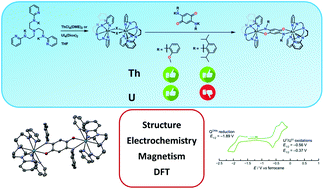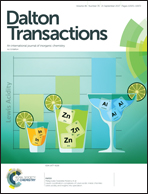Benzoquinonoid-bridged dinuclear actinide complexes†
Abstract
We report the coordination chemistry of the tripodal tris[2-amido(2-pyridyl)ethyl]amine ligand, L, with thorium(IV) and uranium(IV). Using a salt-metathesis strategy from the potassium salt of this ligand, K3L, new actinide complexes were isolated, namely the dimeric thorium complex [ThCl(L)]2 (1) and the monomeric uranium complex UI(THF)(L) (2); under different crystallisation conditions, the dimeric uranium complex is also isolated, [UI(L)]2 (2-dimer). With the aim of studying electronic phenomena such as magnetic exchange between two actinide ions, we have synthesised the first examples of dinuclear, quinoid-bridged actinide complexes from dianionic 2,5-bis[2,6-(diisopropyl)anilide]-1,4-benzoquinone (QDipp) and 2,5-bis[2-(methoxy)anilide]-1,4-benzoquinone (QOMe) ligands. The resulting complexes are [Th(L)]2QDipp (3), [Th(THF)(L)]2QOMe (5) and [U(L)]2QOMe (6). The targeted [U(L)]2QDipp complex (4) could not be isolated. All isolated complexes have been characterised by spectroscopic methods and X-ray crystallography. The uranium(IV) complexes 2-dimer and 6 have been studied by SQUID magnetometry but indicate that there is negligible magnetic exchange between the two uranium(IV) ions. The reduced form of 6, [K(18-c-6)][6−] is unstable and highly sensitive, but X-ray crystallography indicates that it is a novel UIVUIV complex bridged by a quinoid-radical.



 Please wait while we load your content...
Please wait while we load your content...